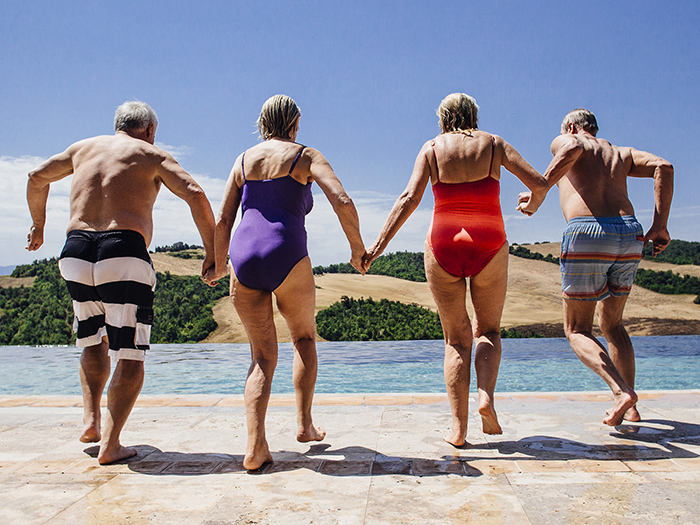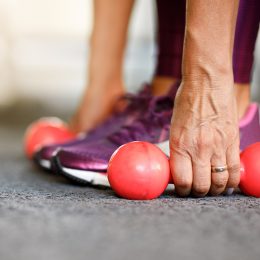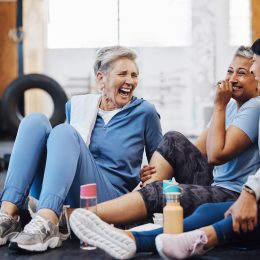4 Signs Your Glutes Are Too Weak
Plus, four exercises that will help you rev up your rear.

Your glutes are much more than just cushy pillows to sit on: They’re the most important muscle group in your body.
“The glutes are our stabilizers,” says Briana Kline, Pilates instructor and founder of Roots of Integrity in Chicago. “They’re what push us forward when walking, help us stand on one leg without our knees caving in, and keep our pelvis from leaning forward or swaying backward.”
In other words, your glutes play a key role in just about everything you do. So keeping them strong is essential for staying active and independent longer. And when they’re lacking in strength, your body will let you know.
Here are four common problems that may be the result of weak glutes, plus the exercises you need to get your rear in gear.
Sign #1: Low Back Pain
If low back pain often puts a damper on your day, consider it a warning that your glutes are sleeping on the job.
“Our brains will call on whichever muscles are needed to perform a function,” says Alice Holland, D.P.T., director of Stride Strong Physical Therapy in Hillsboro, Oregon. “If one group of muscles isn’t up to the task, your brain will order another group to pick up the slack.”
In other words, to help you complete everyday tasks—like bending over to lift something up off the floor—your brain will shift the brunt of the work onto the lower back to compensate for weakness in the glutes. Over time, the added stress on your lower back builds up, leading to soreness, pain, muscle spasms, and possibly injury.
Recent research backs this up. A study published in the journal PLOS One found that middle-aged women with chronic low back pain had much smaller butt muscles than their pain-free counterparts. And the smaller the muscles, the more medical visits women made to address low back pain.
Sign #2: Knee Pain
Achy knees are often written off as an inevitable side effect of getting older. And while it’s true knee pain has many age-related causes (namely, arthritis), chances are weak glutes are a big part of the problem, Kline says. If you’ve been diagnosed with arthritis, strengthening your glutes can at least help offset some of the pain you might experience, she says.
Your glutes—the gluteus medius in particular—play a starring role in stabilizing your knees as you walk, stand, and chase after your grandkids.
“If you don’t have musculature above the knee to stabilize where that knee is in space, it will just go catawampus,” Holland explains. For most people, the tendency is to let the knees fall inward, as that’s where they feel most stable, she says. But then, unfortunately, they start to feel pain.
Sign #3: Balance Problems
“When my patients have poor balance,” says Holland, “it usually means they have weak glutes as well.”
This is because your glutes provide a stable base from which your arms and legs can move. If that base is weak and unstable, your limbs become weak and unstable as well.
Sign #4: Trouble Climbing Stairs (or Keeping Up on the Pickleball Court)
The glutes are a powerful, thick, and fibrous muscle, Holland says. As such, they play a major role in generating power. If you look at sprinters, gymnasts, football players, and other power athletes, you’ll notice they all have noticeably strong behinds.
Your daily to-do list may not require you to chase wide receivers, but it surely involves climbing stairs, going for walks, or playing tennis with friends. All of these activities require power, and power requires strong glutes.
If you get easily tired or winded from climbing stairs, or you can’t return a volley as quickly as you used to, chances are your glutes need work. “Everyone chalks loss of power up to old age,” says Holland. “But it’s often because of weakness in the glutes.”
Do These 4 Essential Exercises to Strengthen Your Glutes
If you’re experiencing any of the issues above, or simply want to prevent them, try adding these exercises into your weekly routine. Integrate one or two into your regular workout or string them all together for a full butt-building session.
Remember: The exercises here may be different or more advanced than those you’ll experience in a SilverSneakers class. If you have a chronic condition, balance issues, or injuries, talk to your doctor about how you can exercise safely.
Exercise #1: Bodyweight Squat
The squat is a great bang-for-your-buck exercise: It strengthens your glutes, abdominals, and all the big muscles in your legs, including the quads (front of your thighs) and hamstrings (back of your thighs), Holland says.
How to do it: Stand tall with your feet shoulder- to hip-width apart. Hold your arms straight out in front of you at shoulder level, and brace your core. This is your starting position.
From here, push your hips back, and bend your knees to lower your body into a squat, not letting your knees cave in as you do so. Pause at the bottom for two seconds, then squeeze your glutes to return to standing. That’s one rep. Perform two sets of 10 reps, or as many as you can until you feel it in your legs. Aim to do this exercise three to four times per week.
Learn how to make the squat easier (or harder) for your needs in this guide.
Exercise #2: Standing Hip Extension
This move targets the gluteus maximus—the largest muscle in your body—and teaches you to stabilize your core to keep your pelvis centered, Holland says.
Subscribe to our newsletter
It's quick and easy. You could be one of the 13 million people who are eligible.
Already a member? Click to discover our 15,000+ participating locations.
Follow Us
How to do it: Stand tall facing a wall, kitchen counter, or back of a sturdy chair, holding onto it for balance. Keeping your back straight, brace your core, and allow both legs to bend slightly.
From here, lift one leg straight behind you as far as you comfortably can, making sure not to further bend your knee as you do so. Don’t worry about how high you can lift your leg; what matters is that you’re able to squeeze your glutes without using your back muscles to compensate, Holland says.
Pause for three seconds, then slowly lower your leg to return to starting position. That’s one rep. Do 10 reps, and then repeat with your opposite leg. Perform two sets total three to four times per week.
Exercise #3: Clamshell
Clamshells build strength in the gluteus medius, the muscles on the sides of your hips that help stabilize your pelvis while you walk.
How to do it: Lie on one side with your legs stacked and knees bent at a 45-degree angle. Keeping your hips steady and your top foot down, lift only your top knee as high as you can. Lower your top knee back to the starting position. That’s one rep. Do 10 reps, and then repeat on the other side. Perform two sets total three to four times per week.
Reminder: How high you’re able to lift your knee doesn’t matter. What’s important is that you activate your hip muscles without rotating at the pelvis, Holland says.
Exercise #4: Single-Leg Stand
Kline loves single-leg balancing exercises for building glute strength and stability. This exercise also has a tremendous impact on your ability to perform everyday activities that require supporting yourself on one leg at a time, such as walking and climbing stairs.
How to do it: Stand tall with your feet together, and brace your core. From here—holding onto a wall, counter, or sturdy chair for balance, if necessary—lift your right foot just off of the floor so that you’re standing on your left foot. Imagine a string through the crown of your head is pulling your spine straight toward the ceiling, and engage your core to avoid leaning to one side. Hold this position for 30 seconds or as long as you can, then repeat on the opposite side.
Kline recommends doing this exercise every day if possible. If you want to make it harder, add in some single-leg kicks: Engage your glutes, and alternate reaching your floating leg forward, backward, and to the side 10 times. Then, switch legs and repeat.
Take Your Favorite SilverSneakers Classes Online!
SilverSneakers members can access live fitness classes and wellness workshops through SilverSneakers LIVE. See the latest schedule and RSVP for classes here.
Not a member? If you have a Medicare Plan, it may include SilverSneakers—at no additional cost. Check your eligibility instantly here.





